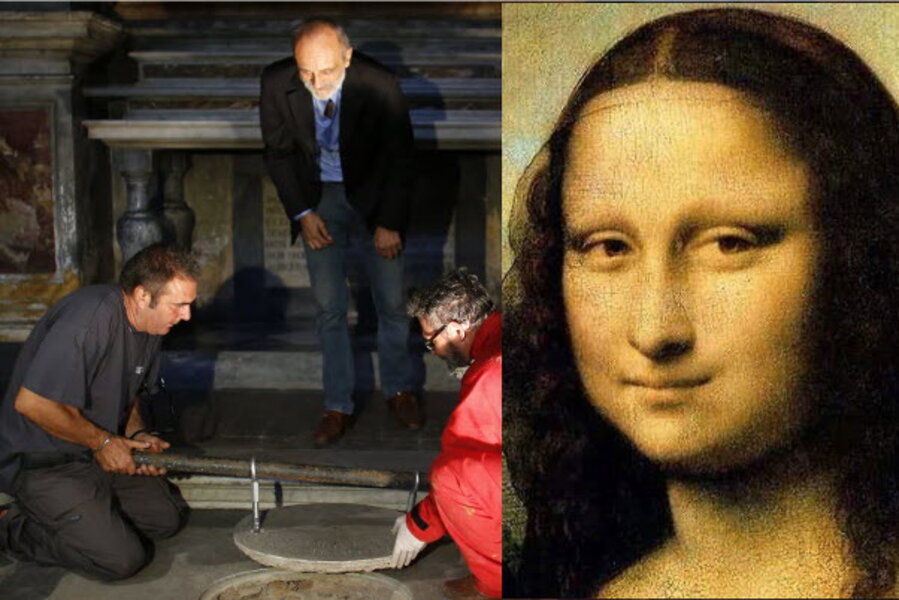Decoding Mona Lisa: Have archaeologists found the face behind the smile?
The most mysterious smile in art history has spawned endless speculation. Who was the model? Why is she smiling? What does the background mean? Whole books have been devoted to musing about hidden messages in the painting, including asking whether the model was actually a man, or had bad teeth, or maybe was Leonardo da Vinci himself.
While speculation continues, most art historians have now coalesced around the idea that the model was a young woman named Lisa del Giocondo, née Lisa Gherardini. "Mona" is a contraction from "madonna," which in Italian means "my lady."
Are the historical Lisa and the subject of the Mona Lisa one and the same? Archaeologist and art historian Silvano Vinceti is determined to answer the question for once and for all, and he's willing to cut into centuries-closed tombs to do it.
In 1495, at the age of 15, young Lisa Gherardini became the third wife of a prosperous silk and cloth merchant, Francesco di Bartolomeo di Zanobi del Giocondo. Francesco already had one son, Bartolomeo, and together Lisa and Francesco had five more: Piero, Camilla, Andrea, Giocondo, and Marietta. After Francesco's death, Lisa retired into the Saint Ursula convent in Florence, where she is believed to have been buried.
The Mona Lisa was commissioned between 1503 and 1506, say researchers at the Louvre, when da Vinci was between patrons and thus perhaps looking for private work. He did not finish it – and was not paid for it – and he ultimately took the painting with him when he moved to France, a decade later. The painting entered the collection of King Francis I, da Vinci's final patron, and was one of the original pieces of art in the Louvre collection.
Last year, Mr. Vinceti's team dug up crypts under the basement of the convent believed to be Lisa del Giocondo's final resting place. "After 1500, only two women were buried here: Mona Lisa Gherardini, in 1542, and another noblewoman, Maria del Riccio," said a statement from researchers. Other historians challenge that, pointing out that hundreds of women were buried at the convent, and existing records are sparse.
Vinceti found the remains of eight women in the crypt, three of which were sent for carbon dating. Finding a skeleton that dates from the 1500s would be compelling, but not convincing, admits Vinceti, who heads Italy's National Committee for the Promotion of Historic and Cultural Heritage.
For confirmation, Vinceti opened the del Giocondo family crypt on Friday, where Francesco is buried with some of his children. The del Giocondo family tomb is inside the so-called "martyrs' crypt" beneath Florence's Santissima Annunziata basilica, which has remained sealed for three centuries. To get in, Vinceti borrowed a page from Indiana Jones – he cut a round hole, about two feet across, into the stone floor of the church, through which researchers were lowered into the crypt.
If Vinceti can find a genetic link between one of the children and one of the women buried in the convent, that will be the smoking gun, he argues.
"When we find a match between mother and child – then we will have found the Mona Lisa," he told Reuters.
At that point, Vinceti hopes to get a forensic reconstruction of the woman's face, to compare it to the Mona Lisa's painted face.
Da Vinci's painting has captured imaginations for five centuries. Indeed, Vinceti himself in 2011 argued that the painting's model was a young man, specifically Gian Giacomo Caprotti, known as Salai, one of da Vinci's apprentices and companions.
"If we succeed, we can finally resolve three questions which have obsessed historians and art-lovers worldwide," Vinceti said. "Was Gherardini the model for the Mona Lisa? Or was it some other model, as some people say? Or is it just a construction of the painter's fantasy?"






